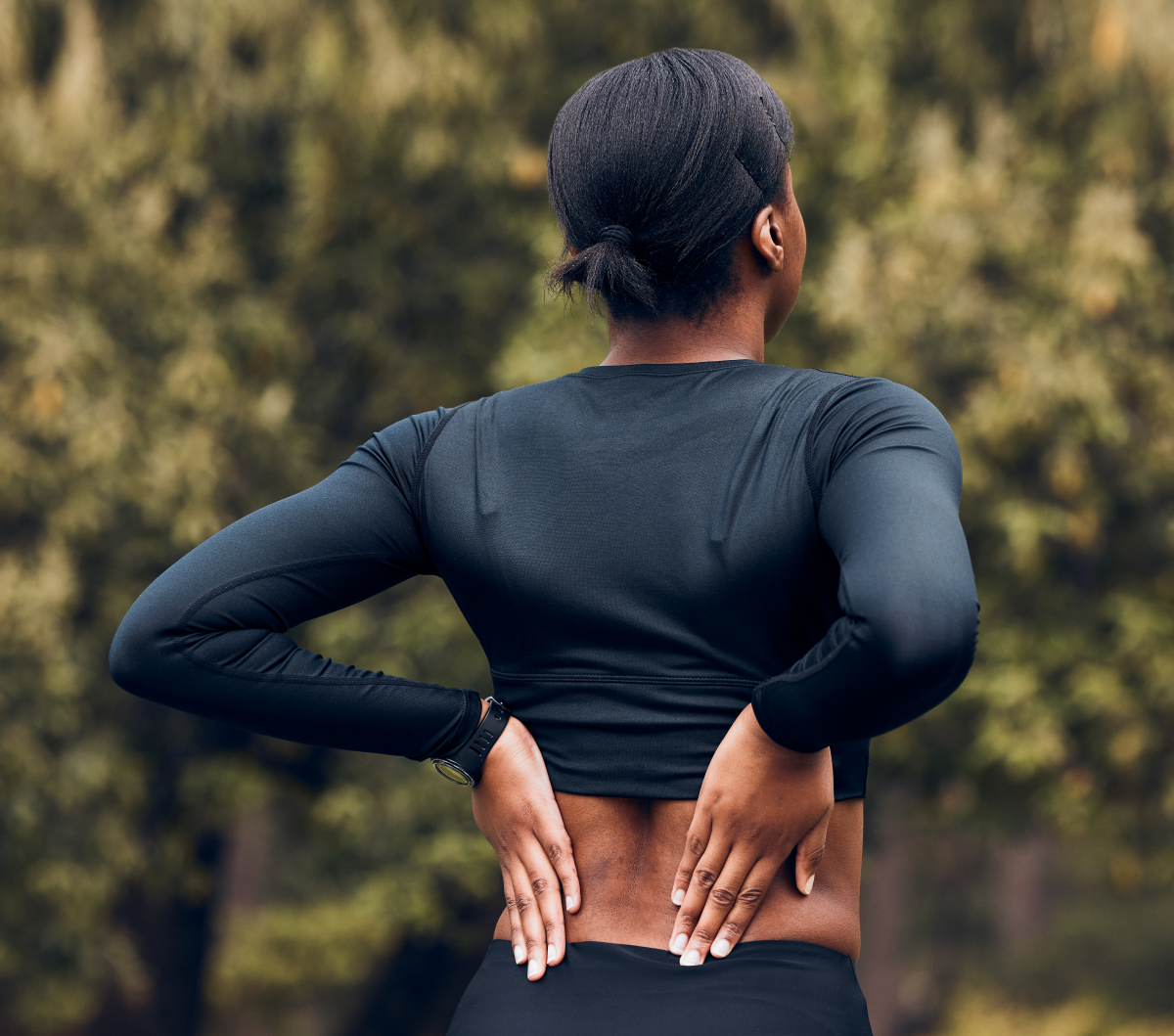How to Stop Back Pain While Walking: 6 Stretches and Exercises That Work
Whether you’re dealing with upper or lower back pain while walking, understanding the root causes and learning proper stretching techniques can help you walk pain-free.

Walking is one of the best workouts around. It’s safe, effective, and accessible, and you can do it almost anywhere and anytime. You don’t need any special equipment or skills to enjoy the benefits of walking. Just slip on your shoes and head out the door!
Whatever your health, fitness, or weight loss goals are, walking will help you achieve them, one step at a time.
However, there is a downside to walking; some people find that it causes back pain. This can affect the upper or lower back and can make walking uncomfortable enough that you don’t want to do it.
While you should always get back pain checked out by a licensed medical professional, there are several things you can do to help relieve and prevent back pain caused by walking.
In this article, we reveal the common causes of back pain while walking, and what you can do about it.
Why Does Walking Cause Back Pain?
The spine is a column of 33 individual bones called vertebrae which are separated by cartilaginous disks, connected by ligaments, and controlled by numerous muscles. There are two inward and two outward curves, which give the spine its classic S shape.
This complex structure means that there is a lot that can go wrong with your back, which helps explain why back pain affects so many of us. However, when it comes to back pain due to walking, most issues are the result of muscle tightness and muscle weakness.
Prolonged sitting, poor posture, previous childbirth, and unbalanced workouts can cause some muscles to tighten up while weakening others. This combination of tightness and weakness pulls your upper and lower back out of alignment, putting stress on areas of your back that, in turn, cause pain.
The good news is that fixing tight and strengthening weak muscles is a relatively straightforward process involving exercises you can do at home.
Related Articles
Exercises for Stretching Tight Muscles
Muscles often have unusual names with Greek or Latin origins. Thankfully you don’t need to know these names to stretch what’s tight. That said, here are the names of the muscles that you need to stretch to alleviate and prevent lower and upper back pain while walking:
- Iliacus and psoas major (collectively known as the iliopsoas), also called the hip flexors.
- Rectus femoris, one of the quadriceps, located on the front of the hip and thigh.
- Erector spinae, the twin columns of muscles running up either side of the spine.
- Quadratus lumborum, located on either side of the spine between the lower ribs/spine and upper pelvis.
- Pectoralis major, also known as your pecs, and essentially your chest muscles.
Stretching these muscles will require a little time and effort but you’ll be rewarded with less back pain while walking.
Do the following exercises for 30-60 seconds at least once a day to alleviate muscle tightness and improve flexibility. You can also do them before and even during your walk if needed.
1| Standing Quad Stretch
Step-by-step instruction for standing quad stretch (also called standing quadriceps stretch):
- Stand next to a wall or handrail and use it for balance.
- Bend one leg and grab your foot.
- With your thighs together, gently pull your heel in toward your butt.
- Hold until you feel your thigh muscles starting to relax.
- Extend your hip slightly to achieve a deeper stretch.
- Release your foot, switch legs, and repeat.
2| Cat Cow Stretch
Step-by-step instruction for cat cow stretch (also called cat cow erector spinae stretch):
- Kneel on all fours with your hips directly over your knees and your shoulders over your hands.
- Gently lift the middle of your back up toward the sky as you look down and back toward your knees.
- Next, lift your head and lower your abdomen toward the floor to arch your lower back.
- Smoothly alternate between these two positions until you feel your lower back starting to relax
3| Kneeling Hip Flexor and Quadratus Lumborum Stretch
Step-by-step instructions for kneeling hip flexor and quadratus lumborum stretch:
- Kneel down and take a step forward with your left leg so your knees and hips form right angles.
- Keeping your torso upright, ease your hips forward to stretch your hip flexors. Move your front foot forward if you need a deeper stretch.
- Simultaneously reach above your head with your right arm and lean gently to the left to stretch your waist.
- Hold until you feel your muscles starting to relax and then switch sides.
4| Standing Chest Stretch
Step-by-step instructions for standing chest stretch:
- Stand in good posture and place your hands behind your head.
- Pull your shoulders down and back.
- Gently press your elbows back to open and stretch your chest.
- Hold this position until you feel your chest muscles start to relax, taking care not to overarch your lower back.
Exercises for Strengthening Weak Muscles
Weak muscles make it harder to stabilize your spine and maintain proper posture. Consequently, your tight muscles can easily pull your back out of alignment, causing that dreaded pain as you walk.
The muscles that are most likely to be weak are:
- Gluteus maximus, better known as your glutes and basically the muscles of your butt.
- Core, the collective name for the muscles that surround your midsection, including the rectus abdominus, obliques, and transverse abdominis.
Do 2-3 sets of the following exercises 3-4 times per week to strengthen the muscles that can cause back pain while walking.
1| Dead Bugs Stretch
How to do dead bug stretch:
- Lie on your back with your legs bent, feet off the floor, and arms extended toward the ceiling.
- Engage your abdominals and use them to press your lower back into the floor.
- Inhale and stretch out your left leg and right arm while keeping your back pressed into the floor.
- Exhale and return to the starting position.
- Repeat on the opposite side.
- Continue until you are no longer able to keep your back pressed into the floor.
- Rest for 1-2 minutes and repeat.
2| Glute Bridge Stretch
How to do glute bridge exercise:
- Lie on your back with your legs bent and feet about 50 centimeters from your bottom.
- Rest your arms on the floor by your sides.
- Drive your heels into the floor and lift your hips up into the air. Feel the contraction in your glutes and hamstrings.
- Hold for 2-3 seconds, lower your butt back to the floor, and repeat.
- Continue until you feel the target muscles starting to tire.
- Rest for 1-2 minutes and repeat.
Closing Thoughts
Don’t let lower back pain stop you from enjoying the health and fitness benefits of going for a walk. Instead, stretch your tight muscles, strengthen your weak muscles, and enjoy pain-free walking.
While these exercises probably won’t cure walking-related back pain overnight, they should provide temporary relief and reduce your discomfort. But, do them regularly, and back pain due to walking should become a thing of the past.




